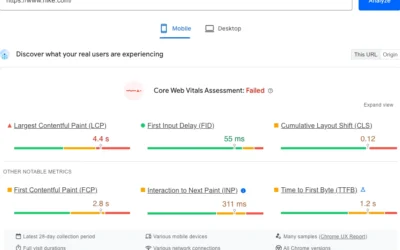How To Use Interstitials in SEO

What are interstitials in SEO?
Interstitials in SEO refer to the pop-up ads or overlays that appear between the transitions of pages. These can sometimes be intrusive and affect user experience, leading to penalties by search engines like Google. Google has specific guidelines regarding interstitials, and if they are deemed to be intrusive or disruptive to the user experience, they can negatively impact a website’s search engine rankings. It’s important to use interstitials sparingly and ensure that they do not interfere with the user’s ability to access the content on the page. It’s also important to make sure that interstitials are easily dismissible and do not cover a significant portion of the page. Following these best practices can help avoid penalties and maintain a positive user experience on a website.
What Is an Intrusive Interstitial?
An intrusive interstitial is a pop-up that covers the main content of a webpage, making it difficult for users to access the desired information. These can disrupt the user experience and are often considered intrusive by search engines. Intrusive interstitials can be ads, newsletter sign-up forms, or other promotional messages that appear before the user can access the content they are interested in. Search engines like Google have guidelines around the use of interstitials, and they may penalize websites that use intrusive interstitials by lowering their search rankings.
It’s important for website owners to consider the impact of intrusive interstitials on the user experience and to find ways to balance their promotional goals with providing a positive browsing experience for their visitors. This can include using less intrusive forms of advertising or ensuring that interstitials are easy to dismiss and do not obstruct the main content of the webpage.
How to Identify Intrusive Interstitials
Intrusive interstitials can be identified by their impact on user experience. If they hinder the access to content or are difficult to close, they are likely to be considered intrusive. Additionally, if they cover a significant portion of the main content, they are also considered intrusive interstitials. When assessing a website for intrusive interstitials, it’s essential to consider the overall impact on user experience and whether the interstitials hinder the user’s ability to access and engage with the main content.
Here are some specific characteristics to look for in identifying intrusive interstitials:
- Size: If the interstitial covers a large portion of the screen, making it difficult for the user to see the main content, it can be considered intrusive.
- Difficulty to close: If the interstitial is hard to close or requires multiple attempts to dismiss, it can be seen as intrusive and frustrating for the user.
- Disruption of user flow: If the interstitial interrupts the user’s flow while trying to access the main content, such as immediately upon entering a website or when navigating between pages, it is likely intrusive.
- Obscuring content: If the interstitial covers essential content or requires the user to take action before being able to view the main content, it can be considered intrusive.
- Distraction: If the interstitial distracts the user from the main content or is designed to grab attention in an aggressive or disruptive manner, it is likely intrusive.
When are intrusive interstitials acceptable to use?
Intrusive interstitials should be used sparingly and only when necessary, such as for age verification or cookie usage notifications. It’s important to ensure that they do not significantly hinder the user’s access to the main content and can be easily dismissed. Additionally, they should not be used in a way that disrupts the user experience, such as popping up too frequently or being difficult to close. It’s also important to consider the context in which the interstitial is being used and whether it’s actually adding value to the user. Overall, intrusive interstitials should only be used when there’s a legitimate need and when they can be implemented in a way that doesn’t negatively impact the user experience for example in Australia there are regulations that you must include an intrusive interstitial as a gate page before users can continue.
Google’s interstitial penalty
Google’s interstitial penalty refers to the potential impact on a website’s search ranking if it utilizes intrusive interstitials. Websites that employ intrusive interstitials may see a decrease in their search visibility and user traffic, as Google aims to prioritize websites that offer a seamless user experience without intrusive interruptions. Interstitials are pop-up ads or messages that cover the main content of a web page, often prompting users to take a certain action or view an advertisement. While some interstitials are necessary for legal or age verification purposes, excessively large or difficult-to-dismiss interstitials can negatively impact user experience.
In 2017, Google announced that it would start penalizing websites that use intrusive interstitials, as these interruptions can hinder a user’s ability to access the content they are looking for. This penalty primarily affects mobile search results, as mobile users are more likely to be affected by intrusive interstitials due to the smaller screen size.
Websites that use interstitials in a way that is considered to be intrusive may see a decrease in their search rankings, making it more difficult for users to find their websites through Google. This penalty serves as an incentive for websites to prioritize user experience and avoid using overly intrusive interstitials.
It’s important for website owners and marketers to be mindful of Google’s guidelines when using interstitials, ensuring that they do not negatively impact the user experience or risk being penalized in search rankings.
Ready to take your SEO to the next level?
Now that you have read about SEO on the blog, it’s time to plan your next move. Please book a strategy session, and we can discuss your plan of action.

Shane Hampson
Ethical SEO Consultant
Data Driven Marketer. Fantasy Football Champion. Dog Lover. Foodie.
Read more posts by: Shane Hampson
Ready to take your SEO to the next level?
Now that you have read about SEO on the blog, it’s time to plan your next move. Please book a strategy session, and we can discuss your plan of action.
Recent Blog Posts
Using PreLoad, PreConnect and Prefetch for SEO
Learn how to use pre-load, pre-connect and pre-fetch to boost your SEO site speed and Core Web Vitals.
How To Optimize For Core Web Vitals
Core Web Vitals are a set of specific factors that measure loading performance, interactivity, and visual stability of a web page, and they are crucial for providing a good user experience and improving SEO.
Creative Ways to Use Regex in Google Analytics and Search Console
How to use regex in your reporting for Google Analytics and Google Search Console.



